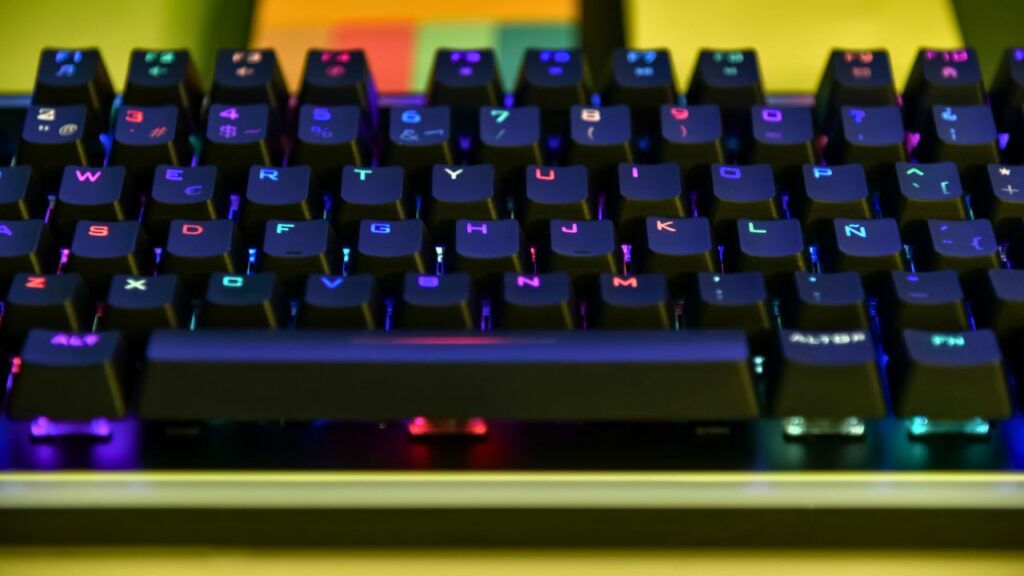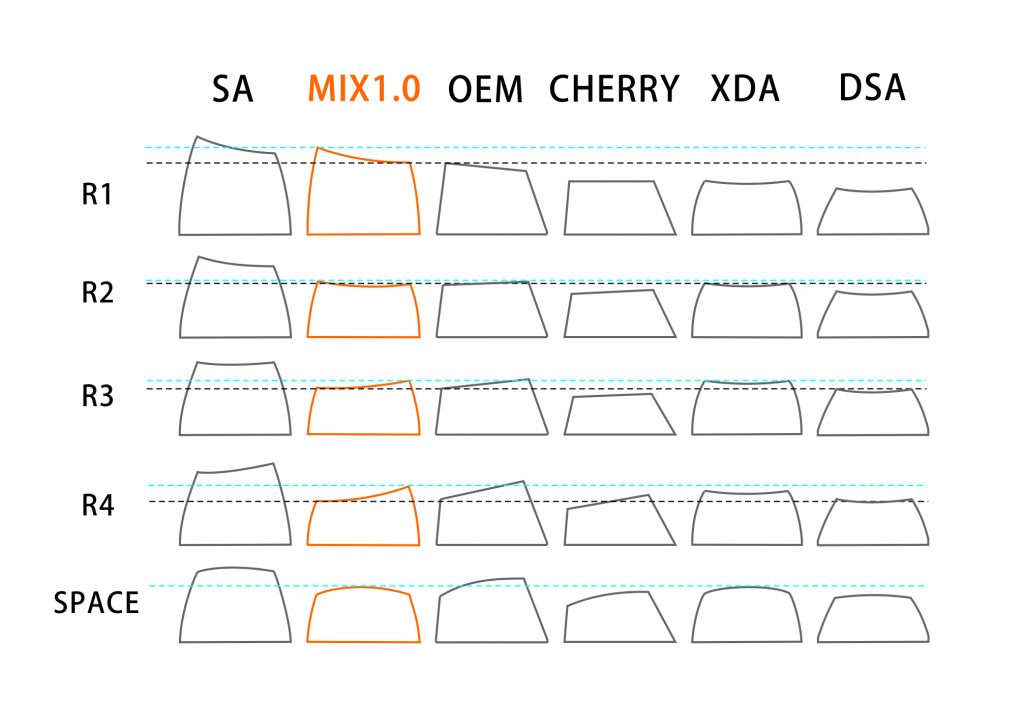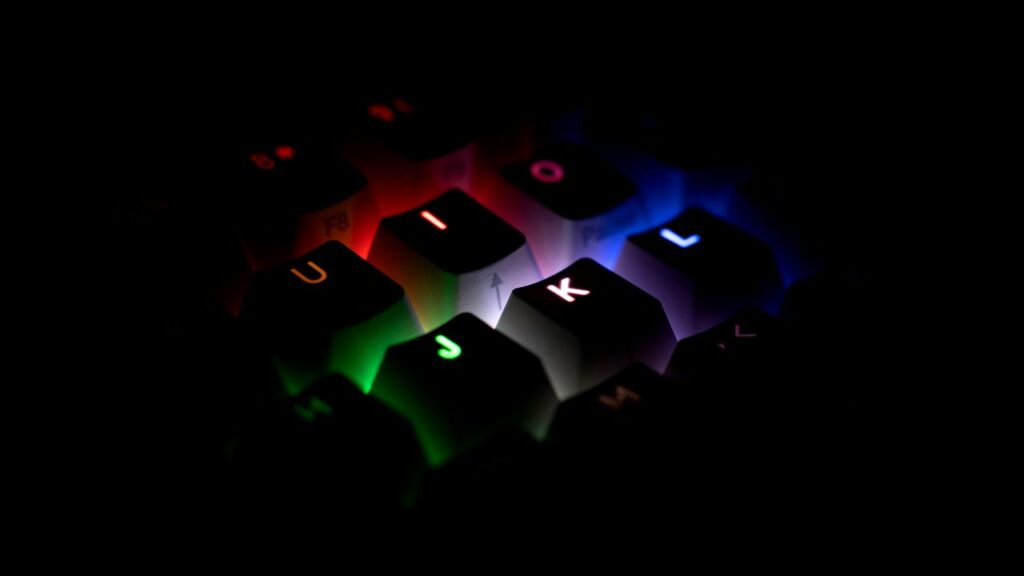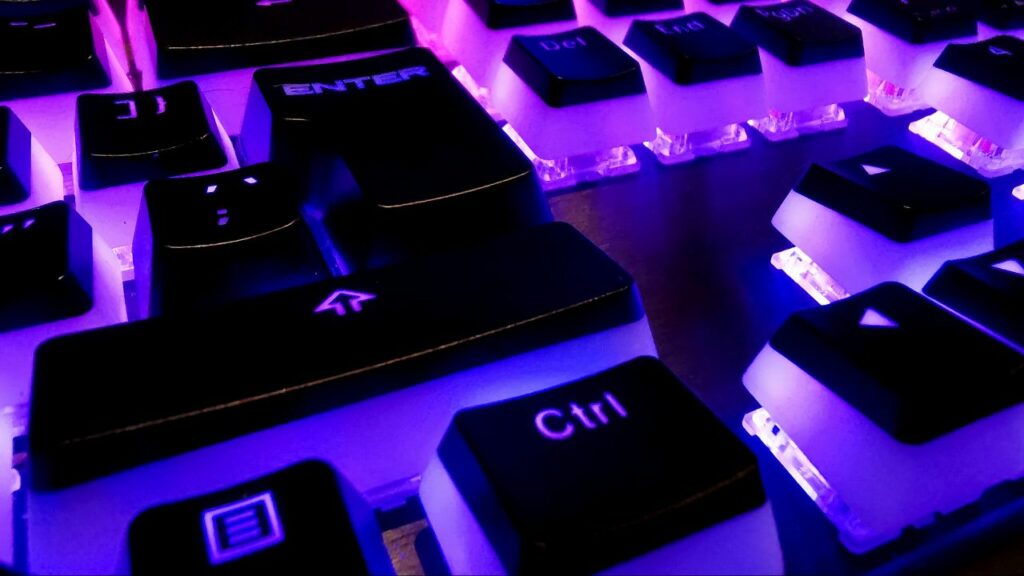
A part that is often forgotten when buying a new keyboard is the right keycaps. It might seem like it won’t make much of a difference, but having the right keycaps will make it last longer and significantly affect the overall feel of the keyboard.
To help you choose best keycap sets in 2023, we’ll look at:
- The material
- The keycap profile
- The printing technique
- Custom keycaps
Let’s start with the first thing to consider, the type of plastic of the keycap:
Choosing the Right Keycap Material
When looking at keycap sets, almost all are made of either ABS or PBT. (However there are more keycap materials availble that we have written about here.) This is what ABS and PBT means and the differences between the two:
ABS Keycaps

ABS stands for Acrylonitrile Butadiene Styrene, one of the most common materials in stock keyboards. ABS is a durable material that excels at representing bright, vivid colors.
It’s easy to mold the plastic, so ABS keycaps tend to be consistent with crisp legends. Many affordable ABS keycaps are available, although not as common in upgrade kits as PBT plastic. Typing and gaming on an ABS keycap is a comfortable experience, thanks to the smooth finish.
The downside to ABS is that it tends to wear down and leave a shiny gloss on the top of the keycaps. Some gamers like the glossy look, but it’s not for everyone. For the best products check out our guide to the best ABS keycaps.
PBT Keycaps
PBT, or Polybutylene Terephthalate, is a more dense plastic commonly found in both upgrade kits and premium mechanical keyboards.
PBT keycaps tend to be thicker and more durable than ABS keycaps. However, they have lower fractal resistance, which means they’re more prone to shatter.
The downside of PBT keycaps is that they are not as vivid as ABS keycaps and the colors look a bit more muted.
When it comes to the feel of PBT keycaps, expect a slightly rougher textured surface. It still feels smooth but is not as soft as an ABS keycap. For the best products check out our guide to the best PBT keycaps.
Choosing The Right Keycap Profile

The shape of the key is known as the keycap profile, and there are many different profiles.
Choosing the right keycap profile is important since it will affect how comfortable the keys feel and how they sound. Keycap profiles have different heights, surfaces, surface areas, and designs. The first step in choosing the right keycap profile is to decide if you want to go for a uniform or a sculpted keycap profile:
Uniform vs. Sculpted
The keys have different shapes on different keyboard rows on sculpted keycap profiles. Sculpted keys reduce travel distance when moving your fingers between different rows. This makes sculpted profiles the most recommended profile for typing.
Keys with uniform profiles have the same shape all over the keyboard. Generally, it’s not recommended to start out with a uniform profile since they take some time to get used to. However, many enthusiasts prefer keys with uniform profiles and are always on the lookout for new custom keycap sets with uniform profiles. Keycaps are not always universal and the profile of the keycap set you need depends on your keyboard, so it’s important to check compatibility before buying.
The most common keycap profiles are Cherry, OEM, SA, and DSA. Let’s have a look at these different keycap profiles:
Cherry
Cherry is like the gold standard in sculpted profiles, loved for its cylindrical shape and relatively low height. If you’re caught between typing documents and gaming, Cherry’s versatility might just win you over. Brands like HK Gaming, Infinikey, JTK, and GMK are notable mentions here. If you’ve ever wondered why GMK keycaps fetch a higher price, their sought-after Cherry profile plays a part. For an in-depth understanding, consider reading this comparison of Cherry vs. DSA.
OEM
A tad higher than Cherry, the OEM profile is another sculpted favorite, commonly found in premium gaming keyboards. While not as popular in custom sets, Tai-Hao offers some outstanding OEM keycaps. For those deciding between OEM and Cherry, this OEM vs. Cherry profile article could be an enlightening read.
SA
Ah, the SA – tall, curvy, and undeniably distinct. This highly contoured profile isn’t everyone’s cup of tea due to its height, but if you’re looking to make a statement, the SA might just be it. However, brace yourself for the price tag; quality SA keycaps can lean towards the expensive side. Dive deeper with SA vs. Cherry and SA vs. DSA comparisons, or explore its dynamics with the OEM profile.
DSA
For those leaning towards uniform profiles, DSA might pique your interest. Flat without curvature, DSA keycaps maintain a medium height, offering a consistent feel across the board. While they might pose touch typing challenges for some, the profile has a committed fan base. For insights into how DSA fares against Cherry, check out this DSA vs. Cherry comparison.
Now, while we didn’t delve into the XDA profile in this guide, it’s worth noting for those keen on exploring further. Here are some quick reads on XDA vs. Cherry, XDA vs. OEM and XDA vs DSA for the curious minds out there.
Advanced Keycap Profiles
As you delve deeper into the world of mechanical keyboards, it’s only natural to become more curious about the intricacies that define the typing experience. Keycap profiles are more than just a design aspect; they play a significant role in influencing the feel and sound of every keystroke. For those eager to explore beyond the mainstream, let’s dive into some advanced keycap profiles.
MDA Profile
For starters, the MDA profile is a captivating choice. This sculpted profile, with its medium height, offers a gentle curve that supports touch typing, allowing fingers to glide effortlessly across keys. Especially ideal for those who spend countless hours typing, it’s a profile that beautifully marries form and function.
MT3 Profile
Then, there’s the MT3 profile. This deeply sculpted profile offers a unique touch with pronounced curves. While it might remind some of the vintage keyboard days, it has made a powerful comeback, particularly among enthusiasts who yearn for a blend of nostalgia and modernity.
XVX Profile
Moving on to the latest buzz in the keyboard realm: the XVX profile. Emerging in the early 2000s, the XVX keycaps’ uniqueness is in their broader design, offering typists and gamers extra space between keys for a more natural hand placement. This feature, combined with their ergonomic elevation, provides enhanced comfort and reduced fatigue during long typing or gaming sessions. Made from premium materials like PBT and ABS plastic, they promise durability and a tactile experience that feels good under your fingertips. Another intriguing aspect is their compatibility with MX keycaps, making them a versatile choice for DIY keyboard enthusiasts. Interested in diving deeper into the XVX profile? Explore more about its design, features, and benefits here.
MT3 vs SA
Ah, the age-old comparison. For many, choosing between the MT3 and SA profiles becomes a pivotal decision. While both profiles boast a high contour design, there are subtle differences that can significantly impact your typing comfort and efficiency. Curious about the intricacies that differentiate the two? This detailed comparison between MT3 and SA can shed light on their distinct characteristics.
To a novice, these profiles might seem merely aesthetic choices. However, as many keyboard aficionados would attest, it’s these nuances that can redefine your interaction with your board. Whether you’re coding, gaming, or drafting an important email, the right keycap profile can elevate your experience.
For those who find joy in gaming, consider how these profiles might influence your in-game reflexes. Could a sculpted profile make the difference in those high-pressure moments? While it’s subtle, every advantage counts.
Printing Techniques
The symbols on the keys are also known as legends. How the legends are printed will impact how they look and whether the symbols will fade or rub off over time. There are many different techniques for printing the legends, each with its advantages and disadvantages.
Pad-printed
Cheaper and older keyboards tend to have pad-printed keycaps. They are cheap to make and work by applying the ink directly onto the top of the keycap. The downside of pad-printed keycaps is that they will fade over time.
Laser-engraved
Laser-engraved keycaps are commonly found in RBG keyboards. The legends are printed by using a laser to engrave the symbols into the key. Laser-engraved keys will last longer than pad-printed keys, but they won’t last as long as dye-sub and double shot keycaps.
Dye sub

The legends of dye sub keycaps are engraved to the key cap material using a heat treatment process known as dye sublimation that works by heating the dye so sublimates, which means it goes directly from its solid form into a gaseous state. The gas is then absorbed into the material of the keycap. This means it will have a smooth surface, and the legends won’t fade over time.
Double shot
Double shot keycaps are made using two pieces of plastic, one for the outer shell and one for the legend. The plastic is then “shot” or injected and molded together. These keycaps are durable and will never rub off or fade. For a comparison between dye sub and double shot keycaps check out this article.
Are Custom Keycaps Worth It?
Absolutely, investing in a set of custom keycaps is well worth it! Selecting the right keycaps can transform the feel and sound of your keystrokes. By choosing the appropriate printing method and keycap material, your keycaps will not only look great but also stand the test of time. However, you need to know where to buy keycaps to get the best custom keycaps on the market. Check out the best artisan keycaps if you’re interested in some really cool custom keycaps. It’s can also be a good idea to make your own custom keycaps. They will be truly unique and crafting them is fun process.
Considering upgrading your Anne Pro 2 or GMMK Pro? There are best keycaps specifically designed for the Anne Pro 2 and exquisite ones tailored for GMMK Pro. Even if budget is a concern, don’t be disheartened. The cheapest keycaps on the market can still offer decent quality.
For the creatives among you, why not consider painting your own? It’s an art, yes, but with guidance, it can be a fulfilling project. Here’s a guide on painting keycaps to get you started. The end result? A keyboard that’s uniquely you.
Of course, we mustn’t overlook maintenance. Keeping those custom keycaps pristine involves some tender love and care. If you’re unsure how, here’s a comprehensive guide on how to wash keycaps.
For the enthusiasts with specific keyboard models, there’s a treasure trove of information out there. Whether you have the Keychron K6, Razer Huntsman Mini, RK61, or the Keychron Q1, there are tailored recommendations for Keychron K6 keycaps, Razer Huntsman Mini keycaps, RK61 keycaps, and Keychron Q1 keycaps. So, rest assured, there’s something for everyone.
To customize your keyboard with new keycaps, you’ll need to remove the existing ones first. A keycap puller is an indispensable tool for safely and efficiently removing keycaps without harming the switches or the keycaps themselves. You have the option to buy a keycap puller, or you can flex your resourcefulness by crafting a custom DIY keycap puller with everyday objects like bent paper clips or tweezers.
What Are Pudding Keycaps?

Pudding keycaps are a great way to add some extra flair and customization to your keyboard set up. With their dual layer design, they allow more light from RGB keyboards to show through, creating a unique look that is sure to impress. Not only do they look cool, but depending on the material you choose between ABS or PBT, they can also provide a comfortable typing experience with different sound levels when typing. When shopping for the best pudding keycaps it’s important to consider shape and compatibility, durability, noise and comfort level as well as aesthetic considerations all while staying within your budget range If you’re a mac user it can be challenging to find backlit keycaps, but luckily we made this guide about where to find backlit keycaps for Mac.
Specialty Keycaps and Care
Navigating the realm of mechanical keyboards is akin to uncovering layers of a rich tapestry—each layer reveals nuances that can transform the typing experience. One such layer that deserves special attention is the world of specialty keycaps. These keycaps, designed with distinct aesthetics and functionalities, can be the secret ingredient to personalizing your keyboard journey.
GMMK Pro Keycap Layout
One of the standout layouts that’s garnered attention recently is the GMMK Pro keycap layout. For those unaware, this layout boasts a design that merges ergonomic considerations with sleek aesthetics. Whether you’re engrossed in an intense gaming session or meticulously crafting code, this layout offers a tactile experience that amplifies productivity.
Cleaning GMK Keycaps
But with specialty comes the responsibility of care. GMK keycaps, with their vivid colors and intricate designs, are a favorite among many. Yet, these beauties require regular maintenance to maintain their shine. Wondering how to keep them looking brand new? Here’s a comprehensive guide on how to clean GMK keycaps. Remember, a little care goes a long way in preserving the aesthetics and feel of these premium keycaps.
ePBT vs GMK
Ah, the conundrum that has left many keyboard enthusiasts pondering. Both ePBT and GMK offer keycaps that are of stellar quality and boast unique designs. Yet, they cater to slightly different tastes and budgets. Dive deep into the comparison of ePBT vs GMK to understand the subtleties that distinguish these two titans.
Specialty keycaps aren’t just about lending a distinctive look to your keyboard. They’re about creating an intimate connection between you and your machine. The right keycaps can infuse each keystroke with a sense of purpose and joy.
While the world of mechanical keyboards offers countless choices, remember that each decision reflects your personality and needs. Whether you lean towards the GMMK Pro’s innovative layout, the vibrant allure of GMK keycaps, or the tactile satisfaction offered by ePBT, there’s a world of possibilities waiting to be explored.
Keycaps and Sound
In the intricate ballet of mechanical keyboards, the sound each keystroke produces is more than just auditory feedback—it’s a symphony of tactile satisfaction and individual expression. Many are intrigued by the chorus of clacks and thuds, often wondering, “Do keycaps actually play a role in this performance?” The short answer? Absolutely.
For many, the journey into mechanical keyboards starts with a quest for tactile feel, but it soon delves deeper into the realm of acoustics. Whether you’re typing away in a serene office space or in the heat of an online multiplayer match, the sound accompanying each keystroke creates an ambiance, setting the mood and rhythm of your activity.
At the heart of this acoustic experience are the keycaps. They act as the first point of contact between your fingers and the switches beneath, playing a pivotal role in shaping the sound. For the curious minds who’ve pondered over the science and art of this relationship, this article delves deep into how keycaps influence sound. It offers insights, drawing parallels between material choices, keycap profiles, and the resulting auditory nuances.
How to Choose Keycaps: Unique Keycap Sets
In the vast universe of mechanical keyboards, the keycaps you choose are akin to the stars in a constellation – distinct, captivating, and brimming with personality. For many enthusiasts, selecting the perfect keycap set is about creating a visual and tactile experience that speaks to their personal style.
The quest for individuality has led to a burgeoning market of unique keycap sets, each with its own story and allure. For instance, the world of CRP keycaps beckons for those who appreciate a vintage touch. These keycaps, rich in history and craftsmanship, bring a nostalgia-laden typing experience that whispers tales of the past. Their distinctive design and feel evoke memories, making them an instant favorite among those yearning for a classic touch on modern desks.
On the flip side, if sleek modernity and performance drive your choices, the low profile Gateron keycaps might be right up your alley. Tailored for a streamlined typing experience, they seamlessly merge form with function, ensuring every keystroke feels both smooth and responsive.
Whether you’re gearing up for an intense gaming session or preparing for a productive workday, the right keycaps can make all the difference. It’s not just about the tactile response or the audible click; it’s about how those keycaps resonate with who you are.
Conclusion
Choosing the right keycaps can be challenging, but we hope by reading this guide, you’ve gotten a better understanding of what to look for when buying your next pair of custom keycaps. If you want to learn more about some of the best keycaps check out my Razer PBT Keycap Set review and my HyperX Pudding PBT Review.